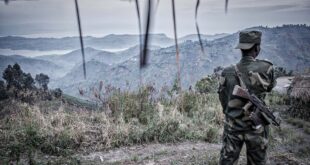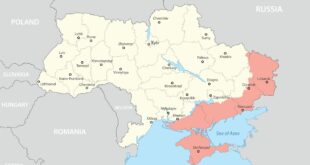The current situation with Israel and Iran illustrates how hardliners in two adversarial countries can play off each other and in effect become each other’s best allies, while jointly becoming the enemies of peace and stability.
The danger of open warfare involving Israel and Iran is increasing. One recent omen was a drone attack, which nearly all observers attributed to Israel, on a military facility in the Iranian city of Isfahan. Israel has been clandestinely conducting lethal offensive operations in Iran for years, but the current increased risk of wider conflict is related to both countries’ politics; extreme and undemocratic features have become especially salient in recent months. The situation could be considered the obverse of democratic peace theory, according to which democracies do not wage war against each other.
Another recent omen is an uptick in Israeli-Palestinian violence, as punctuated by an Israeli raid on a refugee camp in Jenin in the West Bank, leading to the death of ten Palestinians, including a sixty-one-year-old grandmother. Israeli violence against Palestinians unsurprisingly begets Palestinian attempts at retribution, as it did in this case. The spiral of violence between Israelis and Palestinians is spiraling upward. Last year, more than 150 Palestinians died in violent operations by Israeli forces, with about one-fifth that number of Israelis dying from Palestinian violence. Last month, Israelis killed thirty-five Palestinians in the occupied West Bank, making January the deadliest such month in more than a decade.
The connection between Israeli-Palestinian violence and the risk of Israeli-Iranian escalation is twofold. One connection is the perennial Israeli attempt to displace blame and international attention from anything involving Israel by attributing all instability in the Middle East to Iran. This is a major reason for Israel’s stoking of tension and confrontation with Iran, and its rejection and undermining of diplomacy aimed at reducing tensions with Iran. To the extent that the upsurge in bloodshed among Palestinians attracts additional unwanted international attention to the occupation of the West Bank, the Israeli motivation for stoking even more tension with Iran will be all the stronger.
The other connection is that Israel can legitimately point to Iranian support to Palestinian resistance groups such as Hamas and Palestinian Islamic Jihad, although that support is hardly what drives the resistance. Profiling of Palestinian suicide bombers by Israel’s own security forces has found that the common thread among those who resorted to that extreme form of violent resistance was not religion or any other demographic characteristic, much less any foreign support to a resistance group, but instead that each of the bombers had had someone close to them—a friend or family member—killed by Israel. Nonetheless, Israel will use the Iranian link to the Palestinian groups as a rationale for operations such as the Isfahan attack even though Iran is perpetrating no comparable clandestine attacks inside Israel.
The coming to power of the most extreme right-wing government in Israel’s history amplifies the effects of each of these connections. That extremism, along with various measures that Benjamin Netanyahu’s new government has in train such as an emasculation of the judiciary, has led to increased questioning of Israel’s direction by some of its most prominent traditional supporters, including in the United States. The increased need to divert international and especially American attention from that extremism and to shore up foreign support increases the motivation for Netanyahu to keep returning the subject to Iran and to keep promoting hostility toward Iran—just as he did in his recent joint press conference with U.S. secretary of state Antony Blinken.
The far-right composition of Netanyahu’s government also is likely to lead to increased Israeli-Palestinian violence, as a matter both of Israeli provocations and of dashing any Palestinian hopes. One sample of possible provocations was a walk atop what Muslims call the Noble Sanctuary and Jews call the Temple Mount by Public Security Minister Itamar Ben-Gvir, who says he intends to do more of the same. It is worth remembering that a similar stroll on that holy site by another prominent Israeli politician, Ariel Sharon, triggered what became known as the Second Intifada, a multi-year wave of violence in which an estimated 3,000 Palestinians and 1,000 Israelis died.
The dashing of Palestinian hopes involves the determination of this Israeli government, more blatantly and consistently than any other, to prevent Palestinian self-determination. Netanyahu—the closest thing to a moderating influence in this government of extremists—has said as much recently, notwithstanding his earlier lip service to the possibility of a Palestinian state. Bereft of hope for an end to the occupation and apartheid, some Palestinians will see nothing to lose through violent resistance.
On top of this is the government’s encouragement of unofficial violence by Jews against Arabs, especially as perpetrated by West Bank settlers. Netanyahu announced an easing of licensing requirements for owning a firearm, stating that his goal was the arming of “thousands” of Israeli citizens. A foretaste of what West Bank settlers, feeling more empowered than ever with the advent of the far-right government, are likely to do came late last month when settlers made almost 150 attacks against Palestinian residents and their property in a single day.
Whatever the exact nature of the Israeli-Palestinian violence, any upsurge of it plays into the Israeli-Iranian confrontation in the aforementioned ways.
The Iranian end of that confrontation displays some parallel motivations, with a regime that oppresses part of its subject population possibly seeing reasons to heat up external conflict. Especially since the beginning of the current wave of popular protests in Iran, triggered by the death last year of a Kurdish-Iranian woman in official custody, the Tehran regime has shown that it has lost the support of much of its population but has not lost its determination to use whatever means necessary to stay in power. The fall of this regime is not in the cards, but additional violence certainly is.
Most of the officially administered violence is internal to Iran. So far, violence beyond Iran’s borders has been aimed at exiled dissidents—a return to behavior that the Islamic Republic exhibited during its early years. But it is easy to picture Iranian hardliners, beleaguered by the domestic protests, seeing rally-round-the-flag value in an escalated confrontation with Israel. In any event, Iranian leaders will try to respond to Israeli violence against Iran, which is what nearly all past Iranian attempts to hit Israeli targets have been.
Iranian leaders have been given little or no incentive to refrain from any such escalation, considering the sanctions and opprobrium to which their country already is subject. With the Biden administration having continued its predecessor’s failed “maximum pressure” policy toward Iran, Iranian decisionmakers—much like the hopeless Palestinians seeing no end to the Israeli occupation—see themselves as having little or nothing to lose by trying something extraterritorial and violent.
The current situation with Israel and Iran illustrates how hardliners in two adversarial countries can play off each other and in effect become each other’s best allies, while jointly becoming the enemies of peace and stability.
The risk of the United States being dragged into this dangerous situation is significant. Washington has allowed itself to be hitched militarily to an Israeli government that would be happy for the United States to be in the front rank of a war against Iran. The Iranian regime will see little daylight between the United States and Israel. Furthermore, Iran has not closed the books on the Trump administration’s assassination three years ago of one of the most prominent Iranian political and military figures, Qasem Soleimani.
Paul Pillar retired in 2005 from a twenty-eight-year career in the U.S. intelligence community, in which his last position was National Intelligence Officer for the Near East and South Asia. Earlier he served in a variety of analytical and managerial positions, including as chief of analytic units at the CIA covering portions of the Near East, the Persian Gulf, and South Asia. Professor Pillar also served in the National Intelligence Council as one of the original members of its Analytic Group. He is also a Contributing Editor for this publication.
 Geostrategic Media Political Commentary, Analysis, Security, Defense
Geostrategic Media Political Commentary, Analysis, Security, Defense





